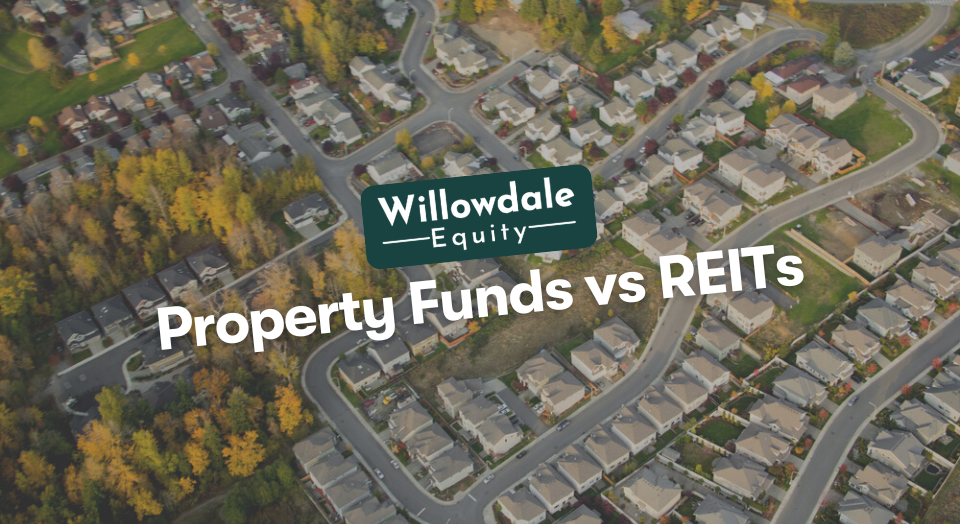
Property Fund vs REIT: What’s the Difference Between The Two?
This article is part of our passive investors guide on real estate syndications, available here.
One of the best investments anyone can make is real estate. The industry has created many millionaires who’ve invested in land and properties. However, investing in land and properties isn’t fit for every investor due to the high upfront capital needed.
REITs and property funds are some of the best options for real estate investors who may not have the high initial capital or time to operate a highly active asset like rental real estate. These options bypass the roadblock by allowing investors to invest passively in income-producing real estate and earn a consistent income.
There’s a common misconception that real estate trusts and REITs are synonymous. The truth is that they’re not.
In this article, we will look at the differences between these two investment options and then explore them individually to help you choose the best one.
Key Takeaways
-
While they’re pretty similar in structure and passive income, they differ in the type of investment, liquidation, and distribution.
-
Property funds are pooled investments where many investors use their capital to invest in various securities. In this particular case, the securities invested are in real estate. Real estate funds acquire, operate, and execute their own real estate assets privately.
-
REITs must distribute at least 90% of their taxable income to their investors as dividends. Some avoid corporate taxes by distributing 100% of the income to investors and passing on the burden of income tax to the shareholders.
Is a REIT a Fund?
A REIT (Real Estate Investment Trust) is a trust, company, or fund that invests in real estate. The structure of a REIT is similar to that of a mutual fund where different investors or shareholders come together to pool their resources and invest in real estate. These shareholders then receive dividend payouts from the REITs on an annual basis.
By law, REITs must pay a minimum of 80% of the annual taxable income to the shareholders. Some REITs pay their shareholders 100% of the revenue in dividends and leave them to pay their income tax. This payment structure means that REIT investors earn a passive income from the fund without being involved in purchasing, managing, or financing the properties.
There are three main categories of REITs, namely:
- Equity REITs: These REITs invest in properties and get their revenue from rental income.
- Mortgage REITs: Mortgage REITs lend other investors money through mortgages and loans. They then get their profits from the mortgage interest.
- Hybrid REITs: These REITs invest in properties and mortgages to spread risk and diversify their portfolios.
Property Fund vs REIT: Here's the Differences

Below is a list of the differences between real estate funds and REITs:
- Type of investment
- Liquidity
- Distribution
- Tax obligations
- Investment and income
Let’s explore each of the differences to understand both investment options better.
Type of Investment
To understand the difference between property funds and REITs, you first have to understand their investment type.
Property funds are pooled investments where many investors use their capital to invest in various securities. In this particular case, the securities invested are in real estate. Real estate funds acquire, operate, and execute their own real estate assets privately.
On the other hand, a REIT is a single trust that purchases, leases, and manages properties, such as office buildings, shopping malls, apartment complexes, medical facilities, and many other types of real estate. Individual investors purchase stocks in the REIT and become shareholders.
These two offer quite similar advantages to investors. Firstly, they generate passive income since you don’t have to worry about purchasing the property or the day-to-day running of the investment. Secondly, you can invest in REIT’s on a major public stock exchange for as little as $1,000, unlike funds that require a higher initial investment. This initial investment varies from fund to fund, but it could be as low as a couple hundred thousand dollars. Thirdly, investors investing in a fund generally get direct ownership in the entity that owns the direct real estate. This extends investors the tax advantages of the business’s operational expenses and the significant depreciation that can be leveraged to further shelter gains from the investment.
Related Read: REIT vs. Syndication: Whats the Difference?
Liquidation
The liquidity of an investment depends on the time it takes to get your cash back when you want to offload the investment. Property funds are less liquid as you can’t sell the asset whenever you want to at market price. It takes time to sell and generate significant returns.
Think of real estate funds as purchasing a single-family home or apartment complex. You get returns from your investment for as long as you hold the property. However, once you choose to sell it, it may take weeks or even months to get a willing buyer. You may not liquidate your asset for a long time.
This isn’t the case with REITs. Since they are publicly traded like the stock market, you can sell your company shares and get your money back whenever you want to. While the money you get back could be a loss based on your market and shares you held, you get your cash back quickly.
On the other hand, the illiquidity of real estate funds comes with a liquidity cost. Private investors in property funds often invest for the long term without having access to their investment. This means that you can’t tap into the investment if you need cash at a certain date. For this reason, you can get higher returns due to the illiquidity cost.
Distributions
These two investment options also differ in how they distribute payments to investors. As mentioned, REITs must distribute at least 90% of their taxable income to their investors as dividends. Some avoid corporate taxes by distributing 100% of the income to investors and passing on the burden of income tax to the shareholders.
Real estate funds distribute the net earnings to investors at least once every year. Funds get their earnings when the fund manager sells one of the investments in the fund’s portfolio for profit.
For example, let’s assume a real estate fund invests in shares in REIT X. Its investors also own the shares owned by the private fund. If the fund decides to sell its shares at REIT X for a higher price than it bought them, the profits are passed on to the investors. You can choose to receive the payment as cash or reinvest them into the fund.
The property fund can also distribute its profits as dividends. For example, if REIT X pays the annual dividends to the fund, the fund can pass the dividend payments to the investors.
Good Read: What is a Real Estate Limited Partnership?
Public vs Private Real Estate
REITs are generally publicly traded like a stock. This means REITs are under strict regulations and often prohibited from investing in some assets. On the other hand, funds are private real estate investments. Property funds give you more control over your investment.
As we mentioned, you can sell your REIT shares any time you want, as you’d do in the stock market. However, REITs are concentrated and institutional.
On the other hand, private real estate funds are patient and picky. They scan for investment opportunities across diverse asset classes and multiple geographical locations to achieve higher returns. Property funds aren’t prohibited from investing in any assets. This means they can offer higher returns than public real estate investments.
REITs are considered less risky since they don’t need a lot of work and only invest in high-quality investments. However, they, in turn, offer fewer returns.
In Which Way do REITs Resemble Mutual Funds?
REITs are similar to mutual funds when it comes to structuring. In both investment options, investors pool their resources to buy a share of real estate properties and then earn income based on their shares. They are also both sources of passive income.
The Tax Advantages that Separates a Property Fund from a REIT

Below are some of the tax advantages that property fund investors enjoy over REITs:
- Tax Deferral: Private real estate fund investors can defer their tax payments while still receiving earnings from the fund. This is a powerful advantage, especially when considering that a dollar today is more valuable than a tomorrow dollar.
- Reduced tax rate: Most of a property fund’s income is taxed at the normal capital gains tax rate if most of the ordinary income produced by a number of funds is eliminated. This is better than being taxed at high ordinary tax rates. Investors can also offset other passive income.
- Depreciation: In commercial real estate, for example, you can take advantage of cost segregation studies and bonus depreciation, which essentially allow investors to shield their income from the asset through large “paper losses” from these depreciation strategies. Direct ownership or structures like a fund or a real estate syndication allow investors to take advantage of that and increase their post-tax rate of return, unlike in a REIT.
Frequently Asked Questions About The Differences Between REITs and a Fund
A REIT is a single company that owns and manages investment properties, where investors buy shares to become shareholders. On the other hand, mutual funds are collections of bonds, stocks, and other types of securities where investors buy a share of the mutual fund.
Real estate funds are privately held, pooled investments that collect capital from many investors to invest in various assets in the real estate market.
REITs have for many years consistently performed better than stocks. Some REITs continue to deliver better returns than many stock options. As an investor, you should consider adding REITs to your portfolio.
REIT vs Real Estate Fund - Conclusion
REITs and real estate funds are both investment options allowing investors to add real estate to their portfolios without buying land or rental property directly. While they’re pretty similar in structure and passive income, they differ in the type of investment, liquidation, and distribution. Be sure to understand both options well and do your due diligence before investing in either.
If you are interested in passively investing in value-add multifamily real estate, with direct ownership and access to all the tax benefits of multifamily, unlike a REIT? Then join the investor club here at Willowdale Equity, where you can access private multifamily real estate syndications of exclusive deals across the southeastern United States.
Sources:
- The Balance, “Real Estate Funds vs REITs: What’s the Difference?“
- Investopedia. “REIT vs Real Estate Fund: What’s the Difference?“
The Willowdale Equity Investment Club is a private group of investors that are looking to passively grow their capital and share in all the tax benefits through multifamily real estate investments.






